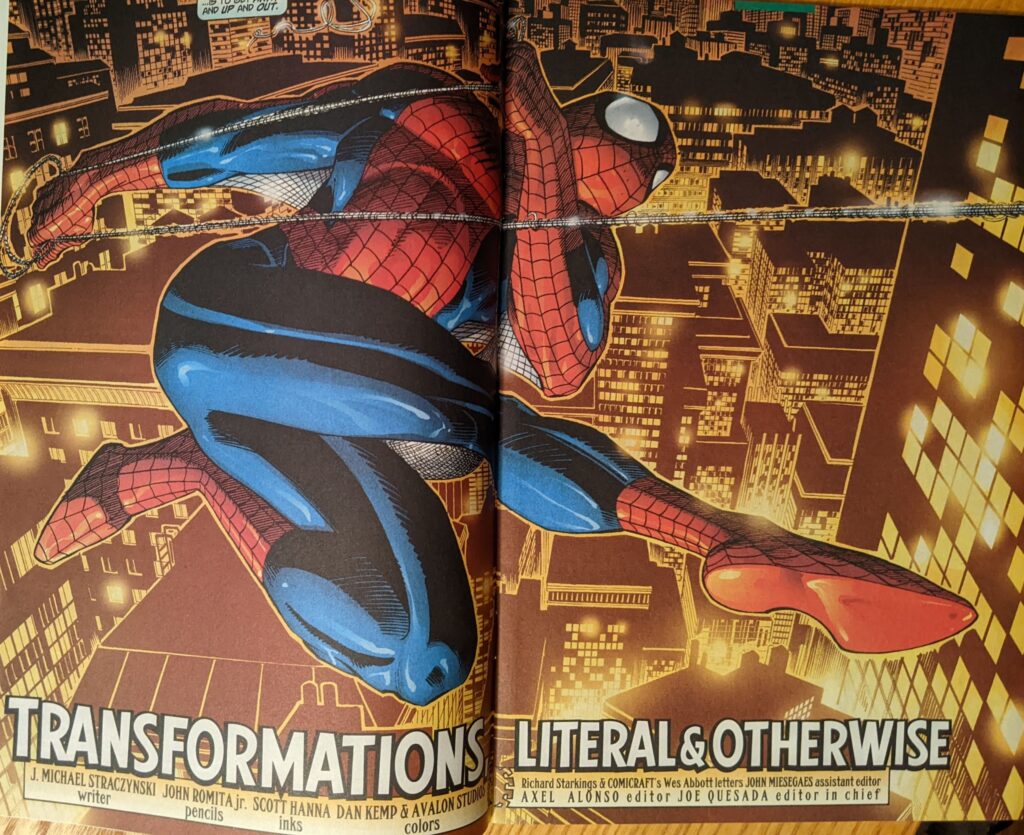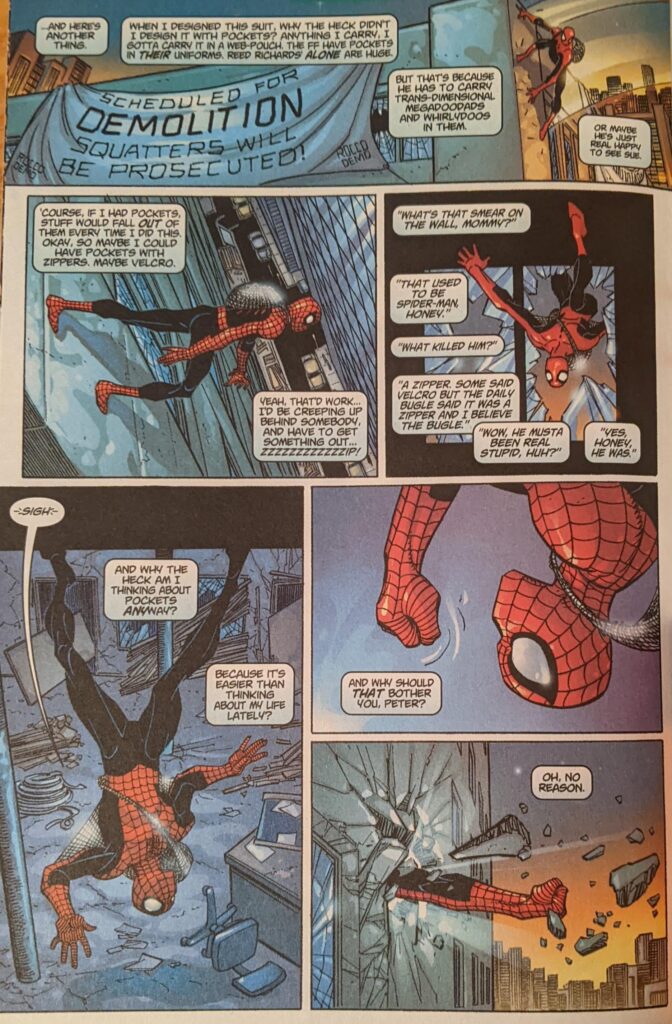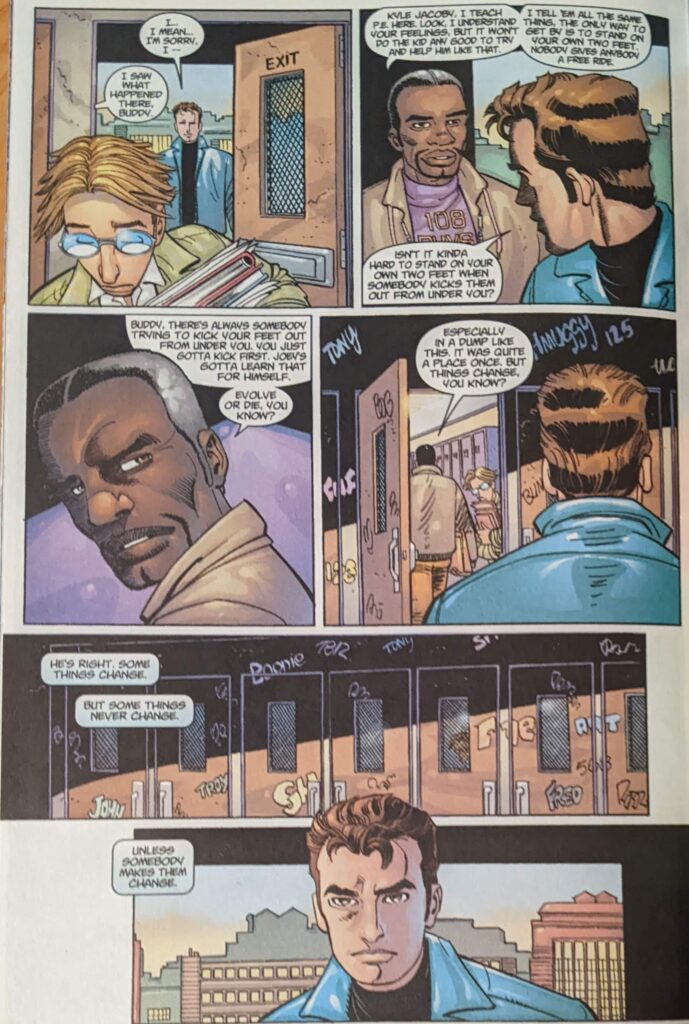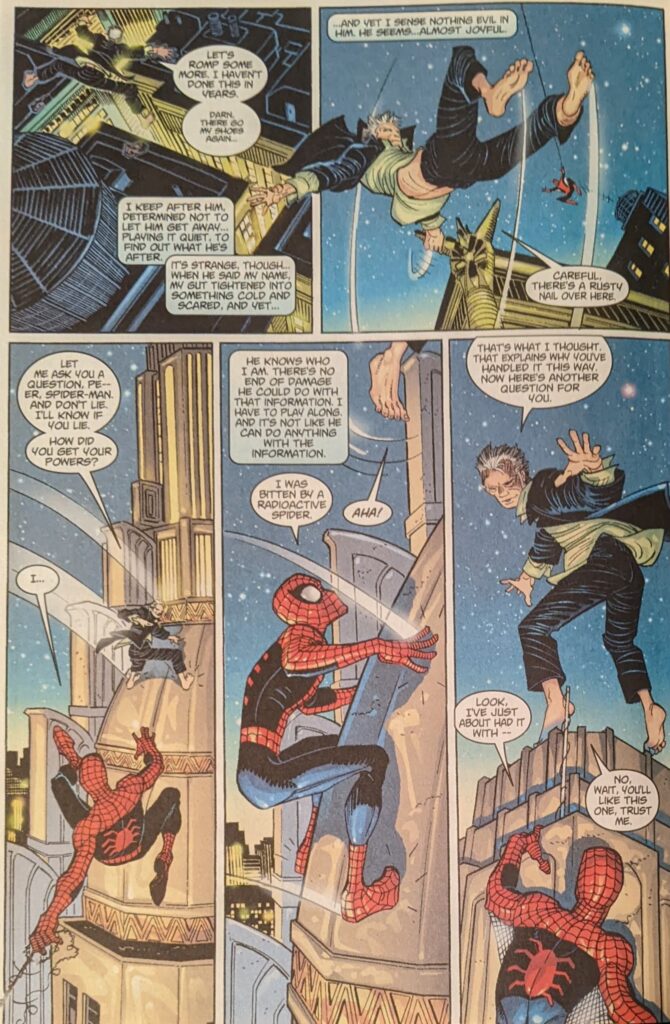Ladies & Gentlemen, please welcome back the classic ASM logo! Mostly! Sort of! Obviously remade in Illustrator, but close enough! A welcome sight, to be sure. And now it can be told. The “new” creative team of ASM is the same line art team, colors by Dan Kemp of Avalon Studios, and writer J. Michael Straczynski. He came to comics from TV, part of Bill Jemas’ endless quest to get anyone but comic book writers to write comics. In his newsletter in 2023, Tom Brevoort said bluntly that Jemas decided comic book writers were all bad, and so was headhunting in any other field, really. After spending the 80s writing for a pretty remarkable amount of the Saturday morning fare I grew up on, as well as things like Murder, She Wrote, Straczynski created Babylon 5, the show that was weirdly similar to Star Trek: Deep Space Nine apparently by coincidence. I had a biology professor at community college with a life size standee of one of the characters in her office. Today people would know him for Sense8. And at the turn of the century, he got into comics. His first home was his own imprint at Top Cow, Marc Silvestri’s imprint at Image. Russian nesting vanity labels! There he created the very successful Rising Stars, and the less important but still popular (And, in my opinion, better) Midnight Nation. Then he was lured to Marvel, and this was his first stop. He’s in for a surprisingly long haul, too, a good 6 years. Most of the people Jemas got to write for Marvel from film and television would do an out-of-continuity miniseries and bounce, but some of them really got into it. He was alleged to have a deal where no editor was allowed to edit his scripts, which is a terrible idea that is not going to end well.
But this issue is the true beginning of 21st Century ASM, and like USM 1, it was an overnight sensation. It is also like USM in that it brings “decompression,” “writing for the trade,” whatever you want to call it to the mainline Spidey books. All Marvel writers seemed to be encouraged to write 6-ish-part stories that would fit nicely into a collection for the bookstore market, a policy DC would soon adopt, and one which both companies more or less maintain even now. A comic where a story is begun and ended in a single issue is a rare occasion now (And yet, almost always highlights of a run, which you’d think would tell them something). While Jenkins seems happy doing short stories and single issue stories, JMS is committed to longform storytelling.
In the late 80s and much of the 90s, the balance of power in comics was upset, and artists became rock stars. As a result, a lot of really bad comics were made, where the plot was way less important than the cool splash pages. Now, the balance begins to tip too far in the other direction, and will stay there. This is the era of the superstar writer. As the 21st Century rolls on, I become more and more frustrated by how little other fans seem to look at the art. I develop the feeling that most people look away from the text just long enough to make sure the red blob talking right now is Spider-Man and that’s it. Comic art has never been more sophisticated, and yet artists have never been working for a less appreciative audience, because story is king. This book as much as any is a big first step in that direction. On the other hand, the writers become stars because of all the wild, fresh stories they put out, as all these people from outside superhero comics like Bendis or outside comics all together like JMS bring in new perspectives and styles, and as editorial allows them to do things no one would have even considered in the decades before. It’s an extremely fun time to read Marvel Comics, one of the all-time great eras. And this book as much as any is a big first step in that direction, too.
But speaking of those 90s artists, another big coup of this issue is getting J. Scott Campbell to do covers. On and off. One of the last true superstar artists, a guy who’s art we’ve seen badly imitated on the blog before, he is the rare big name who didn’t get his start at Marvel, but instead in Jim Lee’s Homage Studios/Wildstorm Comics imprint at Image. His cartoony art, like Jim Lee but more exaggerated, helped set the tone for the back half of the 90s in the industry. And his first work for either Marvel or DC is these Spider-Man covers, and that was a big deal. So, we have the bigshot TV writer, we have this hugely popular cover artist, we have the best Spider-Man line art team you could ask for, and we suddenly have the kind of sophisticated color people expect from an Image comic. The stage set for a bold new era. But what’re they actually doing?

A bold new era and STILL not on nice paper!

An oft-referenced and reused 2-page splash right there. I think it was even on a t-shirt. Our man is just swinging around, trying not to think about his woes, and says he’s going to do so until he gets tired. It’s funny to me that people have retroactively said that this is around when thought balloons were replaced by narrative captions. That it was writers like Bendis and JMS and Warren Ellis who made it happen. As we have seen, it was in progress years before.

Certainly has the motormouth down, even if he’s not talking out loud. As of this issue, I was immediately taken by the shine Kemp put on the suit. I simultaneously thought “Spider-Man’s suit isn’t shiny” and “That looks really cool.” Conflicted! Spidey takes out his frustrations on this condemned building until it’s about really to fall, and then there’s a comedy page of the foreman telling his crew they only have 6 hours demolish it, it collapsing, and them him yelling it’s lunch time. Later, Peter finds himself out of costume, wandering through the old neighborhood, and back to his high school. A flashback implies he went to high school with Gwen and Harry, which is a rookie mistake, JMS! He wanders into the school, which is kind of creepy!, and sees a kid called Joey being bullied. He makes the bullies leave, but Joey says now he’s only going to get it twice as bad later.

It’s so interesting what a fresh coat of paint can do. It’s still Romita, Jr. and Scott Hanna, still doing their top notch work, but this color treatment really takes them to a different level. Color becomes so, so important in the 21st Century, a vastly underappreciated art form, and this is showing why. Later, Spider-Man has been following those high school bullies, which is kind of insane, and sees them trying to break into a car, so he lowers himself down to them and scared them away. And then someone above him says, “I suppose you’re feeling rather proud of yourself right now,” and this book drops the bomb.

That caption in panel 3 is worded really awkwardly.




And there you have it. Such a simple question, but it rocked the Spidey fandom to its core pretty much instantly. We’d seen a lot, but never this. As Spider-Man gapes under his mask, he asks the empty air why Ezekiel would come to him now, and his voice echoes around saying because now is the right time, and because it may help him survive what’s coming. Alone with his thoughts, Peter starts heading home, thinking that guy probably didn’t feel dangerous because he reminded him of Uncle Ben. But, he thinks, he’s been used and abused before, and he even references the recent Goblin scheme, and thinks he doesn’t trust anyone anymore, no matter how much he’d like to. Meanwhile, an old timey sailing vessel has arrived at the harbor, looking like a pirate ship. We see a guy paying to dock it, and a worker helpfully telling him he can put it in an abandoned repair housing to keep it out of the elements. This guy’s name is Dex, and he’s on his way back to the mysterious ship…


And that’s the ballgame. And whatever Morlun turns out to be in this story, lemme tell you Straczynski has no idea what he’s just done. He has unwittingly set the stage for Dan Slott to create the Spider-Verse concept a decade hence. But that, obviously, is getting ahead of myself. An explosive first issue, but also, by the standards of the old school, a pretty empty one. Spider-Man fights a building, talks to a guy, chases Ezekiel around, and then Morlun shows up. That woulda been half an issue in the 70s. But this is the new normal. A new focus on character. It’s an interesting shift.

